Summary
Escofet has refined the Kanji seating elements down to the millimeter. With a seat depth of 40 cm, a height of 45 cm, and armrests 21 cm above the seat, they now fully comply with the SpanishReal Decreto 193/2023 and the European standard EN 17210 – Accessibility and usability of the built environment. This article explores how minor design changes have a major impact on user experience, why ergonomics and accessibility are inseparable, and how retrofit furniture contributes to circular and inclusive urban development.
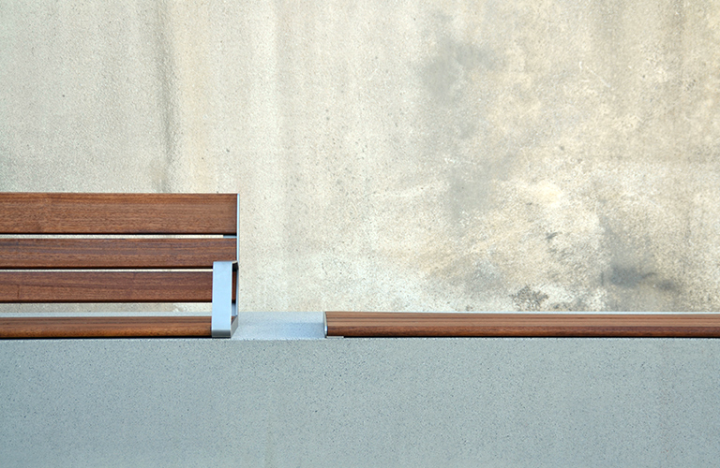
From standards to experience
Public space is the stage of daily life: squares, parks, stairs and walls are places where we pass through, linger and meet. Yet they are not always inviting or accessible. Small design details often decide whether a space is usable for everyone. With the updated Kanji seating elements, Escofet demonstrates that progress can be measured in millimeters.
The Spanish norm for accessibility Real Decreto 193/2023, complementing the older norm Real Decreto 505/2007, introduces stricter requirements for ergonomics and inclusion in the built environment. This regulation aligns with the European EN 17210 – Accessibility and usability of the built environment, which defines minimum standards for usability and accessibility.
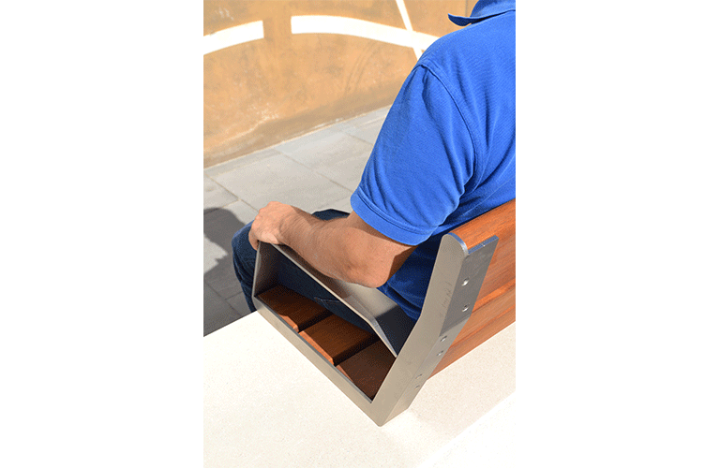
Escofet has embraced this as an opportunity to refine the Kanji system. The changes are not large visual alterations, but small adjustments that make a big difference in comfort and user experience.
Why ergonomics matter in public space
Ergonomics in street furniture goes beyond aesthetics or durability. It determines whether people feel welcome, whether they can use a place independently, and whether public space is truly public. Research shows that seat depth, seat height and armrest placement are decisive for comfort and safety. A seat that is too deep can make it difficult for older people or users with limited mobility to stand up. Armrests that are too low reduce autonomy.
A relevant study underlining this is MDPI – Public Space and Inclusivity, 2023, which concludes that small ergonomic adjustments can have a disproportionately large impact on accessibility and usability of public environments. Ergonomic public seating is therefore not merely a design choice, but a matter of social inclusion.
Millimetres that change the experience
The impact of the refinements lies in the details:
- Seating depth: 40 cm : prevents slipping and remains compact enough to fit on walls and steps.
- Seat height: 45 cm : he most comfortable height for a wide group of users, promoting a natural seating postureg.
- Armrests: +21 cm above the seat : crucial for standing up independently, especially for seniors or those with reduced strength.
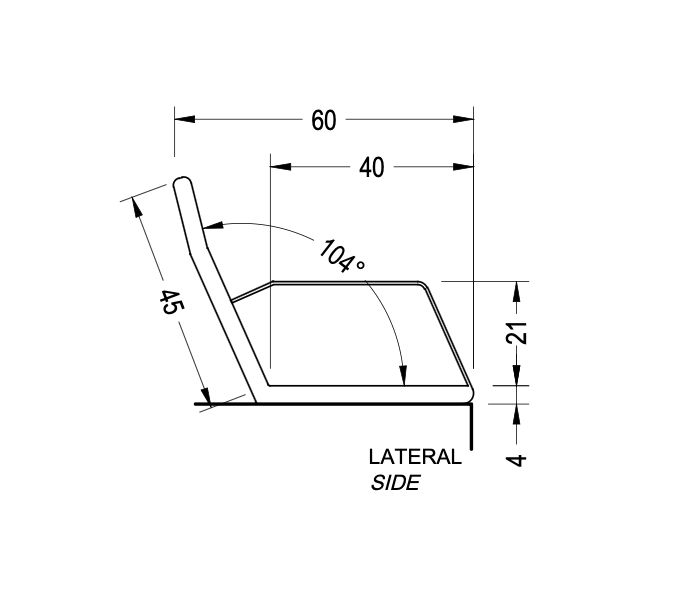
For designers these may seem minor details; for users they mean the difference between dependency and autonomy, between discomfort and comfort.
Universal Design and social inclusion
Universal Design (UD), also called inclusive design – means that environments and products are usable by as many people as possible from the start, regardless of age, size or ability. In public spaces, UD translates into ergonomic furniture with proper seat heights, thoughtful armrest placement and comfortable depths. These micro-decisions reduce barriers, foster independence and make places genuinely inviting for everyone.
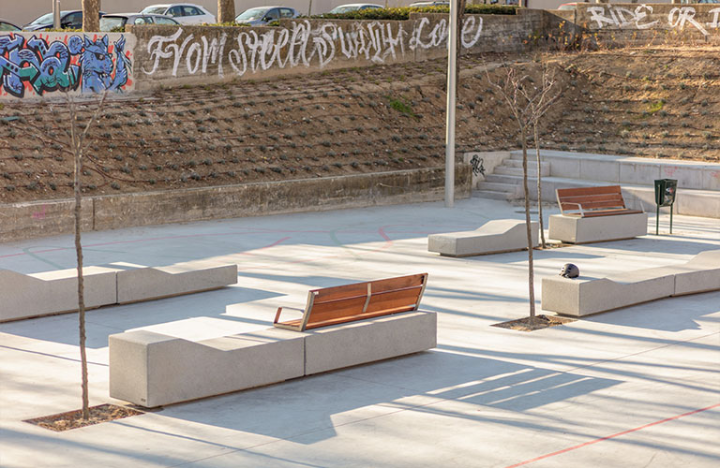
Evidence from Western Europe: UD in practice, not just policy
In Scandinavia, UD is not only adopted at policy level but also applied concretely in streets and squares. A Swedish study shows that UD gains true value when translated into tangible details: benches with optimal armrest heights, bus stops without steps, and plazas where diverse groups feel equally welcome. The researchers report a noticeable increase in independence for seniors and persons with disabilities, as well as stronger social interaction in public environments. More on this :UNIVERSAL DESIGN SWEDEN; Erdtman et al., 2021
Design perspective: seating as a social catalyst
From the design field the same view is echoed: ergonomically tuned seating extends dwell time and stimulates social contact. Hassell Studio – Beyond Ergonomics, 2022, describes how public seating not only provides comfort, but also drives social cohesion when aligned with human scale and context.
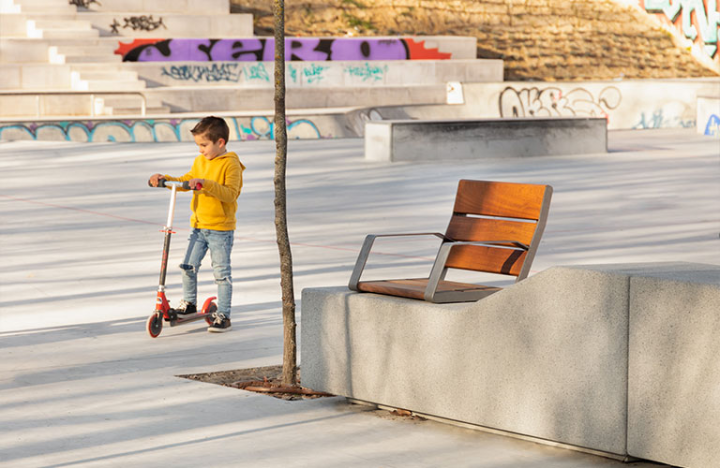
Made tangible in Kanji: millimetres bringing UD to life
Through fine-tuning to the human scale, hard edges become accessible seating. The result fits seamlessly within the principles of Universal Design: more autonomy, more comfort and more social interaction, without heavy interventions.
By adjusting the Kanji dimensions, Escofet contributes to public spaces that invite, connect and support. Accessibility and inclusion are not side issues – they are core values in contemporary design.
Retrofit and circularity: sustainable interventions
A special feature of Kanji is that it is designed as a retrofit solution: seating elements without legs or support structures that can be simply mounted on existing walls, retaining walls or steps. This reduces material use, avoids new foundations, and minimises transport and CO₂ emissions. The prerequisite is that the existing structure has a suitable height to achieve the optimal ergonomic seating level when combined with Kanji.
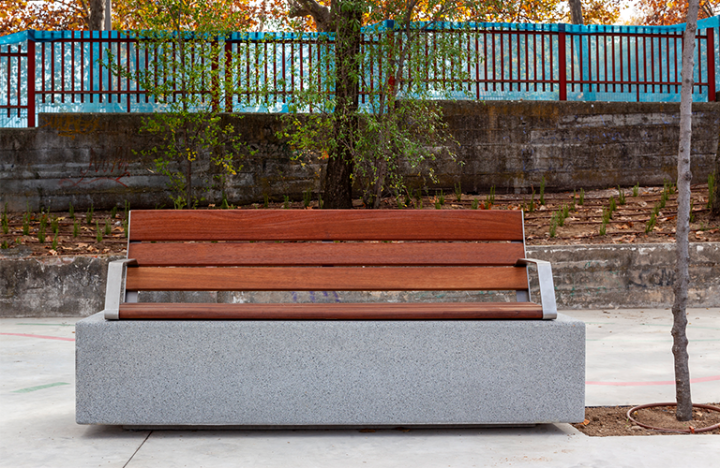
By reusing existing infrastructure, Kanji fits into the framework of the circular economy: less material, faster installation and lower site impact. Where available, reference can be made to the Environmental Product Declaration (EPD) van Escofet 1886 by Molins, for transparent communication of environmental benefits. Read more inour blogpost on the added value of EPDs
More information on the compatibility of Kanji models with other Escofet elements can be found on this page, where we provide concrete examples and applications.
Materials: durability and aesthetics
Kanji is available in several materials, each with specific benefits:
- FSC® wood: a warm look, perfect for parks and green areas.
- GFRP (glass fibre reinforced plastic): colourfast, low-maintenance, resistant to UV and graffiti; ideal for high-traffic locations or coastal areas.
- Steel with C5-coating (C5-M, EN ISO 12944) or stainless steel 316L: weather-resistant and highly durable against road salt and marine conditions.
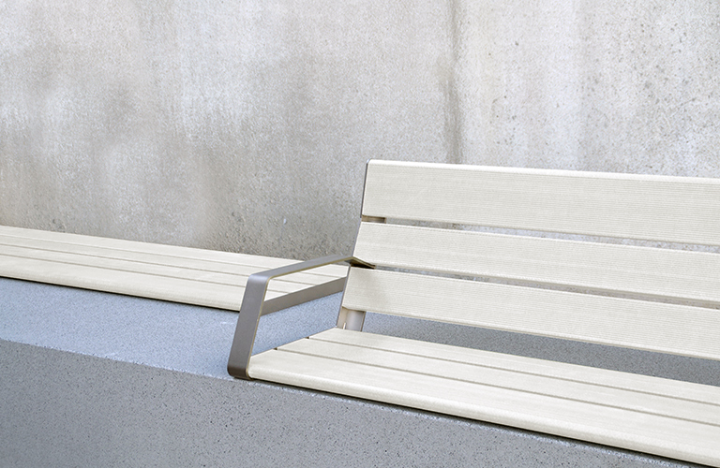
This variety makes Kanji highly versatile: from city squares and campuses to care facilities and coastal zones. Each material strikes a balance between aesthetics, functionality and durability.
Relevance for all stakeholders
Kanji brings value to diverse target groups:
- Cities and municipalities: a simple and cost-effective way to upgrade existing infrastructure to meet new standards. This enhances accessibility, increases public support and demonstrates commitment to inclusion.
- Architects and designers: a seating element that combines ergonomic precision with aesthetic flexibility. Existing walls and steps can be transformed into high-quality seating areas without undermining the design concept.
- Contractors and building partners: easy and quick to install thanks to its retrofit character, with minimal site impact. Saves time, costs and resources.
- Education and healthcare institutions: schools, universities and care campuses benefit from more accessible and comfortable outdoor areas. This boosts usability and contributes to inclusive environments where diversity is valued.
- Investors and developers: by choosing accessible and circular seating, they increase social value and long-term appeal of projects. This provides both public support and reputational gains.
- End users: the real value lies with the people using public space. Thanks to precise ergonomics, they experience more comfort, independence and safety, making spaces more inviting for gathering and socialising.
By bringing these perspectives together, Kanji becomes more than just a product: it is an integrated answer to today’s urban challenges.
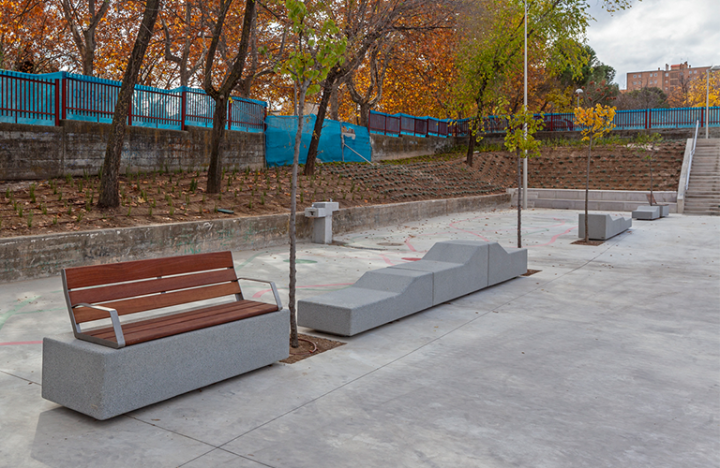
Conclusion: millimetres as a lever for social value
The update of Kanji is more than a technical correction. It is a statement: public space can be designed down to the millimetre to become more accessible, inclusive and sustainable. With small but precise adjustments, Escofet proves that good design starts with attention to detail and ends with a better experience for everyone. Together with Servibo, Escofet places ergonomics, inclusion and circular innovation at the heart of tomorrow’s public realm.
Discover the possibilities of Kanji and other retrofit seating
Want to see how the renewed Kanji models can transform your public space? Explore the various versions and materials below. You will also find a second carousel featuring other retrofit elements from our range, designed to transform hard edges and existing structures into inclusive and sustainable seating.